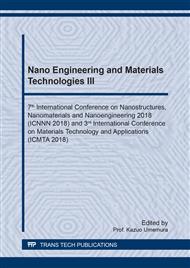p.185
p.190
p.195
p.200
p.207
p.212
p.217
p.222
p.228
Effects of the Reinforcement Positions and Number of Nickel-Titanium SMA Wires on the Structural Properties of HIHFR Beams
Abstract:
This study investigated the effects of the reinforcement positions and the number of shape memory alloys (SMAs) on the structural characteristics of highly intelligent hybrid fiber reinforced concrete (hereinafter, HIHFR) beams. First, tests were conducted under monotonic loading conditions. To examine such structural characteristics, the load-deflection curve relationship and crack patterns, temperature and energy absorption, temperature and displacement ductility, displacement ductility and energy absorption, and the relationship between the displacement ductility and resilience were compared and analyzed. The reinforced concrete beam (RCB) exhibited somewhat excellent values in terms of displacement ductility, but showed the lowest values in terms of strength, resilience, and energy absorption capacity. HIHFR1 exhibited the most excellent results among the test samples in terms of resilience and energy absorption capacity. Therefore, SMAs were partially substituted for the compressive, tension, and shear reinforcement of the existing RCBs. As a result, the substitution for the compressive and tension reinforcement exhibited the best results, confirming the possibility of using SMAs as a substitute for steel reinforcement.
Info:
Periodical:
Pages:
228-235
Citation:
Online since:
March 2019
Authors:
Keywords:
Price:
Сopyright:
© 2019 Trans Tech Publications Ltd. All Rights Reserved
Share:
Citation:


